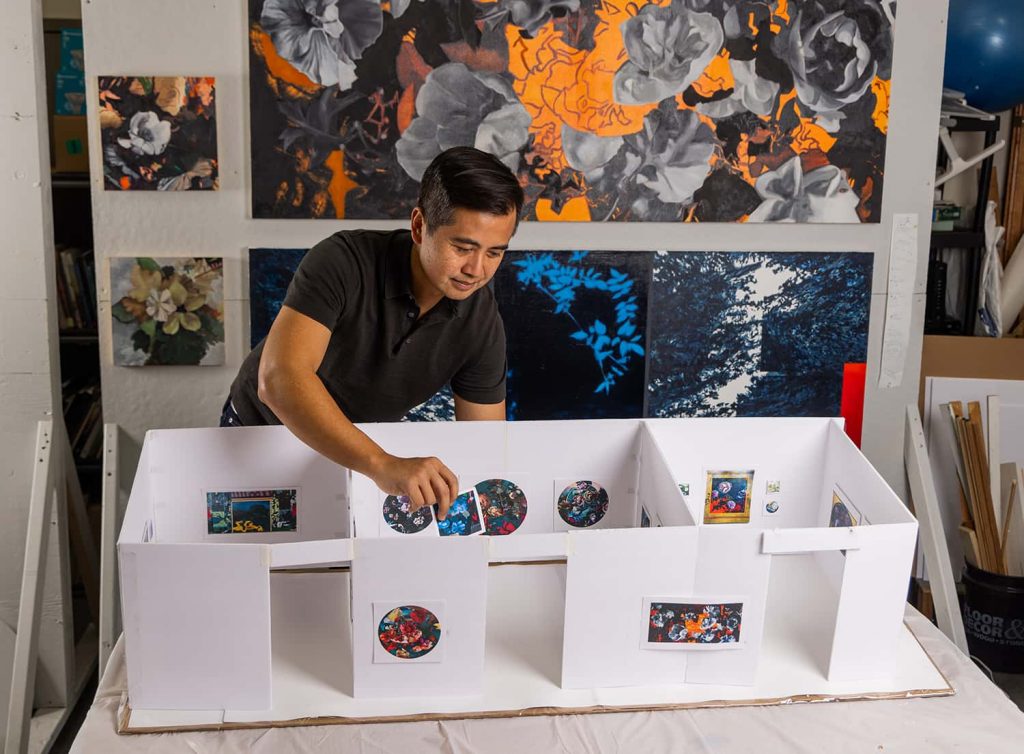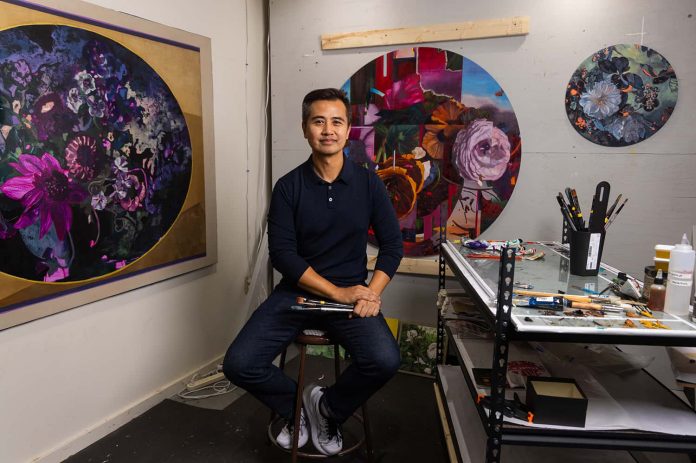Thuan Vu believes in the value of brokenness.
An art and design professor at Southern, Vu is preparing a professional exhibition of his work, “Kintsugi in the New World,” opening this month at the Lyman Allyn Art Museum in New London, Conn.
The exhibit will show, in a series of lush paintings of flowers, how being broken can be gorgeous, according to the Japanese philosophy of Kintsugi.
“Kintsugi in practice is when a piece of ceramics is broken,” Vu said, surrounded by his large paintings, many circular, at his New Haven studio.
“Artists, artisans, will re-form those pieces together and bind the broken pieces together with a line of gold. And that line of gold is proudly shown as a part of the repaired piece,” he said. “And this piece with these fractures repaired, shown, are considered more valuable, more beautiful, because it shows the history of trauma, of fracture, of human hands repairing, and that you become more valuable because there’s more care that you have survived something, that you’re on the other side of this moment where you were broken.
“That process of saying that you are worthy of repair and that you are even more beautiful for having gone through a hard experience and come through the other side: That is what Kintsugi metaphorically meant to me and my work.”
As a young child, Vu immigrated to the United States as a refugee from Vietnam, settling with his family in New Orleans. He later went to Centre College in Danville, Ky., and has traveled extensively since, to such cities as Paris, London, Vienna, Munich, Venice and Florence.
“Wherever there was art, I went. So art made me a global citizen,” he said.
For Vu, the broken spirit of Kintsugi has come out in the contradictions he has had to live with.
“Living in New Haven, you can see the disparity of being a refugee but also being American,” he said. “The question of my identity has always played a huge part in my life. Am I more Vietnamese? Am I more American? Being a gay man, also trying to fit into Catholicism . . . trying to find that sense of wholeness and completeness in your spirit.”
In searching for how to express his identity, Vu has experienced brokenness, living through Hurricane Katrina and suffering a cardiac arrest on the tennis court in his mid-40s (he still plays).
“With the Kintsugi series, I’m showing you the brokenness there,” he said. “You can see the golden fracture, the process of the painting we made. The whole painting was painted in gold first, and then I painted on top of that. And as I went, I responded to whether or not those cracks can show.”
Vu’s newest paintings, which will be shown for the first time in the New London exhibit, are luxuriant arrangements of flowers, tumbling over each other in an abundance of colors.
“These arrangements are these flowers that I put together, and they are fragmented. They are layered on top of each other,” he said. “Much like our thoughts, there are different parts of our lives. You being a partner, you being a professor . . . you being a son, you being a sibling, you being whoever to whomever, and then having to bring all of that together, to create a sense of wholeness, unity.”
It’s the task of bringing all those identities together into one beautiful whole that we carry with us through our lives, he said.
His paintings are layered, with bare canvas appearing at times.
“Is it finished? Is it unfinished? Look at how much care and detail has been put in other parts and into the frame itself, and then showing you the bare linen of the canvas,” Vu said. “Are we hiding the scars? Are we hiding the process, or do we show only our finished product?”
Vu said that he’s creating a new space with his art. “I’m inviting the viewers into my space and into the world that I’m creating,” he said.

Besides teaching his students creative techniques, Vu wants them to bring their personal history into their art, just as he, a queer, Asian refugee, does in his.
“I understand all of those pressures, and through my lens, of course, but it makes me much more sensitive to my students’ willingness to work hard for their future,” he said. “It makes me respect education so much more in the role that it can play in their lives, and that’s why I’m such a tough teacher, because I can’t see a way of making it in this world without working hard and investing in yourself and your mind.”
“Thuan Vu: Kintsugi in the New World” will be shown from Jan. 18 to March 30 at the Lyman Allyn Art Museum, 625 Williams St., New London. Hours are Tuesday to Saturday, 10 a.m. to 5 p.m., and Sunday, 1 to 5 p.m. An opening reception will be held at 5 p.m. on Friday, Jan. 24. RSVP to (860) 443-2545 or info@lymanallyn.org.


